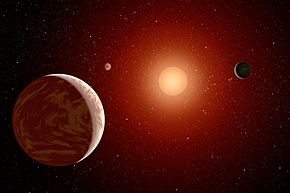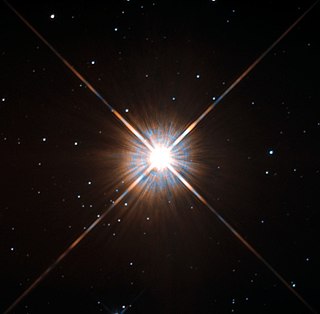
A red dwarf is the smallest and coolest kind of star on the main sequence. Red dwarfs are by far the most common type of star in the Milky Way, at least in the neighborhood of the Sun. However, individual red dwarfs cannot be easily observed as a result of their low luminosity. From Earth, not one star that fits the stricter definitions of a red dwarf is visible to the naked eye. Proxima Centauri, the nearest star to the Sun, is a red dwarf, as are fifty of the sixty nearest stars. According to some estimates, red dwarfs make up three-quarters of the stars in the Milky Way.
GJ 1061 is a red dwarf star located 12 light-years from Earth in the southern constellation of Horologium. Even though it is a relatively nearby star, it has an apparent visual magnitude of about 13, so it can only be seen with at least a moderately-sized telescope.

Wolf 1061 is an M-class red dwarf star located about 14.1 light-years away in the constellation Ophiuchus. It is the 36th-closest-known star system to the Sun and has a relatively high proper motion of 1.2 seconds of arc per year. Wolf 1061 does not have any unusual spectroscopic features.
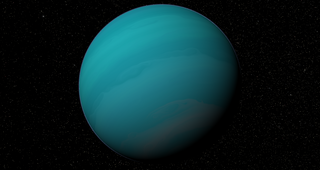
Gliese 876 b is an exoplanet orbiting the red dwarf Gliese 876. It completes one orbit in approximately 61 days. Discovered in June 1998, Gliese 876 b was the first planet to be discovered orbiting a red dwarf.
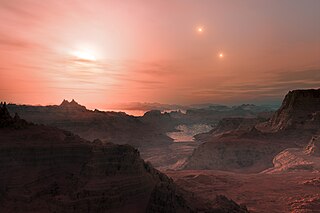
Gliese 667 Cc is an exoplanet orbiting within the habitable zone of the red dwarf star Gliese 667 C, which is a member of the Gliese 667 triple star system, approximately 23.62 light-years away in the constellation of Scorpius. The exoplanet was found by using the radial velocity method, from radial-velocity measurements via observation of Doppler shifts in the spectrum of the planet's parent star.

Kepler-69c is a confirmed super-Earth extrasolar planet, likely rocky, orbiting the Sun-like star Kepler-69, the outermore of two such planets discovered by NASA's Kepler spacecraft. It is located about 2,430 light-years from Earth.
Kepler-61b is a super-Earth exoplanet orbiting within parts of the habitable zone of the K-type main-sequence star Kepler-61. It is located about 1,100 light-years from Earth in the constellation of Cygnus. It was discovered in 2013 using the transit method, in which the dimming effect that a planet causes as it crosses in front of its star is measured, by NASA's Kepler spacecraft.

Kepler-442b is a confirmed near-Earth-sized exoplanet, likely rocky, orbiting within the habitable zone of the K-type main-sequence star Kepler-442, about 1,206 light-years (370 pc) from Earth in the constellation of Lyra.

K2-3d, also known as EPIC 201367065 d, is a confirmed exoplanet of probable mini-Neptune type orbiting the red dwarf star K2-3, and the outermost of three such planets discovered in the system. It is located 143 light-years away from Earth in the constellation of Leo. The exoplanet was found by using the transit method, in which the dimming effect that a planet causes as it crosses in front of its star is measured. It was the first planet in the Kepler "Second Light" mission to receive the letter "d" designation for a planet. Its discovery was announced in January 2015.
Wolf 1061d is an exoplanet orbiting the red dwarf star Wolf 1061 in the Ophiuchus constellation, about 13.8 light years from Earth. It is the third and furthest planet in order from its host star in a triple planetary system, and has an orbital period of about 217 days.

Kepler-1229b is a confirmed super-Earth exoplanet, likely rocky, orbiting within the habitable zone of the red dwarf Kepler-1229, located about 870 light years from Earth in the constellation of Cygnus. It was discovered in 2016 by the Kepler space telescope. The exoplanet was found by using the transit method, in which the dimming effect that a planet causes as it crosses in front of its star is measured.

K2-72e (also known by its EPIC designation EPIC 206209135.04), is a confirmed exoplanet, likely rocky, orbiting within the habitable zone of the red dwarf star K2-72, the outermost of four such planets discovered in the system by NASA's Kepler spacecraft on its "Second Light" mission. It is located about 217.1 light-years (66.56 parsecs, or nearly 2.0538×1015 km) away from Earth in the constellation of Aquarius. The exoplanet was found by using the transit method, in which the dimming effect that a planet causes as it crosses in front of its star is measured.
HIP 57274 d is an exoplanet orbiting the K-type main sequence star HIP 57274 about 84.5 light-years (26 parsecs, or nearly 8.022×1016 km) from Earth in the constellation Cetus. It orbits within the outer part of its star's habitable zone, at a distance of 1.01 AU. The exoplanet was found by using the radial velocity method, from radial-velocity measurements via observation of Doppler shifts in the spectrum of the planet's parent star.

TRAPPIST-1e, also designated as 2MASS J23062928-0502285 e, is a rocky, close-to-Earth-sized exoplanet orbiting within the habitable zone around the ultracool dwarf star TRAPPIST-1, located 40.7 light-years away from Earth in the constellation of Aquarius. Astronomers used the transit method to find the exoplanet, a method that measures the dimming of a star when a planet crosses in front of it.

Ross 128 b is a confirmed Earth-sized exoplanet, likely rocky, that is orbiting within the inner habitable zone of the red dwarf star Ross 128, at a distance of around 11 light-years from Earth. The exoplanet was found using a decade's worth of radial velocity data using the European Southern Observatory's HARPS spectrograph at the La Silla Observatory in Chile. Ross 128 b is the nearest exoplanet around a quiet red dwarf, and is considered one of the best candidates for habitability. The planet is only 35% more massive than Earth, receives only 38% more starlight, and is expected to be a temperature suitable for liquid water to exist on the surface, if it has an atmosphere.
Luyten b is a confirmed exoplanet, likely rocky, orbiting within the habitable zone of the nearby red dwarf Luyten's Star. It is the fourth-closest potentially habitable exoplanet known, at a distance of 12 light-years. Only Proxima Centauri b, Ross 128 b, and GJ 1061 d are closer. Discovered alongside Gliese 273c in June 2017, Luyten b is a super-Earth of around 2.89 times the mass of Earth and receives only 6% more starlight than Earth, making it one of the best candidates for habitability.

Teegarden's Star c is a candidate exoplanet found orbiting in the habitable zone of Teegarden's Star, an M-type red dwarf star 12.5 light years away from the Solar System. It orbits in the conservative habitable zone around its star. Along with Teegarden's Star b, it is among the closest known potentially habitable exoplanets. It was discovered in June 2019.

Habitability of yellow dwarf systems defines the suitability for life of exoplanets belonging to yellow dwarf stars. These systems are the object of study among the scientific community because they are considered the most suitable for harboring living organisms, together with those belonging to K-type stars.
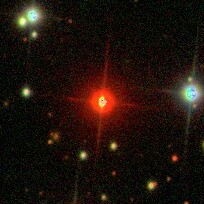
Wolf 1069 is a red dwarf star located 31.2 light-years away from the Solar System in the constellation of Cygnus. The star has 17% the mass and 18% the radius of the Sun, a temperature of 3,158 K, and a slow rotation period of 150–170 days. It hosts one known exoplanet called Wolf 1069 b which could possibly sustain life.
Wolf 1069 b is an Earth-sized planet orbiting the red dwarf star Wolf 1069. Being located in the habitable zone of its star, Wolf 1069 b is considered a potentially habitable planet, as well as being the sixth-closest Earth-mass planet orbiting within its star's habitable zone. The minimum mass of this planet, as measured by the radial velocity method, is 1.26 MEarth, while its radius is estimated at 1.08 R🜨. The equilibrium temperature of Wolf 1069 b is -23 °C.
